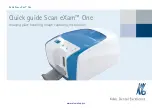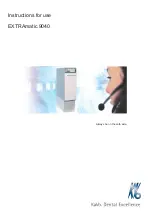
3.2 Safety precautions
3-2
•
The operation of the device is allowed only under the supervision of qualified medical per-
sonnel able to provide immediate care to the patient and, if necessary, to ensure alternative
methods of ventilation in case of device’s malfunction!
•
During ventilation always use a bedside monitor providing a complete and independent con-
trol of the vital parameters of the patient. Leaving the patient unattended be sure that the
sound alarm the device is enabled.
•
While using the device on the patient keep ready the alternative means of ventilation (for ex-
ample, the spare ventilator).
•
While using the device on the patient periodically check the patient condition and proper ven-
tilator function, e.g. on-time data updating on the screen.
•
Ventilation with dry gas after 10 minutes can cause damage of the ciliary epithelium of the
trachea and bronchi and subsequent evaporation from the surface of the alveoli. Do not allow
prolonged ventilation without heating and moistening the gas supplied to the patient.
•
In case of any emergency situation during of the operation (fire, short circuit, etc.), imme-
diately disconnect the device from the patient and continue to ventilate the patient in other
ways. Pull out the power cord from the wall outlet or turn off the device by power switch (Fig-
ure 2.2, position 1). Disconnect the pressure of compressed oxygen.
•
On the rear panel of the device in the mains block there are fuses of T2.0AL/250V type (2
pcs.). Do not replace the fuse without disconnecting the device from the mains.
•
Operation of the device at the removed cover powered from mains is prohibited.
•
Disinfection of the switched on device is prohibited (the power plug must be removed from
the socket).
•
Immersion of electrical connectors of sensors, cables etc. into liquid disinfectant solutions
is
prohibited
.
•
The operation the device may affect equipment in the vicinity, for example, high-frequency
electrosurgical devices, shortwave therapy equipment, cell phones. Do not use the device in
the operating conditions of the nuclear magnetic resonance equipment.
•
The barometric pressure is compensated by ventilator during measurements with main-
stream CO
2
sensor and metabolism measure module.
•
During operation high oxygen concentration are used, so it is necessary to perform the fol-
lowing safety rules:
o
Use only the breathing circuits intended for use in the enriched oxygen environment.
Do not use antistatic or conductive hoses and tubes in the breathing circuit.
o
Connection to the oxygen line is allowed only through regular oxygen filter-regulator
supplied with the device and mounted on the rear of the cap nut with seal.
o
Do not allow oxygen leakage in the place of connection of the filter-regulator to the
compressed oxygen source.
o
Do not use the device together with the explosive anesthetics.
o
Do not use the device near equipment containing industrial oils.
o
Do not use the device if the oxygen hose is damaged or contaminated with industrial
oils.
o
Periodically inspect the filter located in the water trap reservoir of the oxygen regula-
tor. If contaminated immediately replace it with the supplied spare filter.
o
Remove the condensate from the water trap through the valve at the bottom part of
the regulator. Do not disassemble the regulator under pressure!!!
o
When handling with oxygen cylinders comply with the local safety regulations. Al-
ways check the status of the gas cylinders before using.
Содержание MV200
Страница 2: ......
Страница 8: ......
Страница 25: ...2 3 Front panel 2 9 2 3 Front panel Figure 2 1 Front view of the electronic unit ...
Страница 124: ...4 21 Open valve function 4 76 For your notes ...
Страница 158: ...6 11 Check and calibration of mainstream CO2 sensor 6 8 For your notes ...
Страница 160: ...7 Troubleshooting 7 2 For your notes ...
Страница 162: ...8 Transportation 9 Storage 10 Disposal 10 2 For your notes ...
Страница 166: ...13 commission date mark 12 2 For your notes ...
Страница 168: ...14 Maintenance and repair data 14 2 For your notes ...
Страница 196: ...Appendix 2 9 Ideal body weight of the patient IBW App 2 10 For your notes ...
Страница 200: ...Appendix 3 Electromagnetic environment App 3 4 For your notes ...
Страница 201: ...Appendix 4 Pneumatic scheme of ventilator App 4 1 APPENDIX 4 PNEUMATIC SCHEME OF VENTILATOR ...
Страница 202: ...Appendix 4 Pneumatic scheme of ventilator App 4 2 For your notes ...
















































